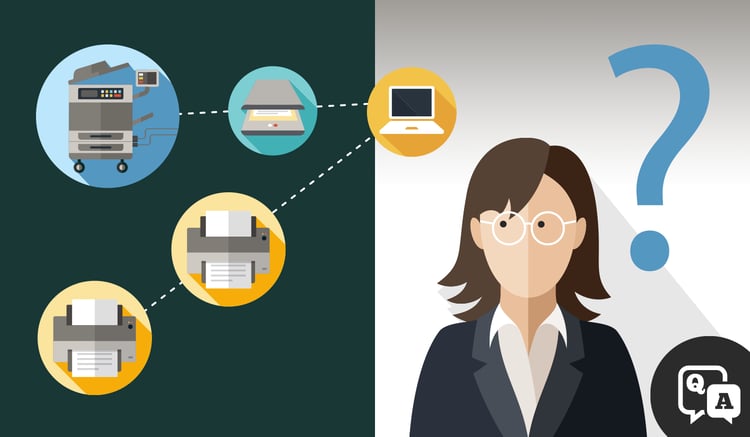
By taking a hard look at several print variables, and comparing the numbers, you can potentially cut costs considerably with a single Multi-Function device.
Ever heard of the Razor and Blades Business Model?
Wikipedia describes it as an item being sold at a low price in order to increase sales of a complementary component to that item… i.e., razor blades, i.e. consumable supplies.
The costs associated with a single function desktop printer can be a lot like the Razor and Blades Model.
All that is to say, the sweet deal on desktop devices could create a false sense of savings. While many organizations may accept it as just “another business cost” without further examination, desktop printers – especially color ones! – can chew into your operating costs significantly. So, if you have several desktop printers around your office, can you save money with a single larger, multi-function unit?
Potentially, you absolutely can. But not without taking a hard look at a few variables first, to determine what your total cost of ownership will be with several desktop printers vs a single Multi Function Printer (MFP) device. Crunching the numbers, and comparing them, over an industry-standard five-year-period on three key components below will be an important first step, certainly not the only one, in identifying what cost savings could potentially exist.
The Three Variables to Consider:
1. The Investment in Hardware:
Consider your initial investment in your hardware device.
First, desktop ink-jet printers are the most expensive printing device you can have in your business. If you were take your car to the gas station and fill it with printer ink, it would cost anywhere around $2,500 per gallon (or considerably more)!
A low-end color laser-based printer price could be as small as $200, while a mid-level model MFP, depending on features and capabilities, let’s just say, is $4,000. Obviously the upfront cost is extremely higher with the MFP. But don’t jump to conclusions yet. There are multiple other operating costs to consider, below.
2. Consumable Costs (Operating Costs):
Factors included in identifying such costs with a printer include cartridge pricing, maintenance kits, as well as the yields for the cartridges. Pulling these numbers together, we can come up with an industry standard average for what your actual running costs are for a particular printer.
The industry standard for calculating costs is at 5 percent coverage (for reference, an IRS 1040 Form is at 8 percent coverage). Remember, too, that a color printer requires 4 cartridges (one for each color). So how often does your $200 printer need a new $85 cartridge, based on a period of 5 years? What is your yield on those cartridges? Are you using OEM or compatible cartridges?
Based on these factors, it could add up to an extremely expensive cost per page.
3. Volume (Overall and Color):
How much are you printing on those devices? And more specifically, how much color are you printing?
If your overall volume is 10,000 and 8,500 of that is color, your savings will be much higher than if those numbers are switched. (Remember that industry standard of 5%? Now you’re looking at 20 percent coverage for color prints). I’ve seen circumstances where a color desktop printer can be 30 cents or more per page. Compare that to an MFP cost of 6.5 to 7.5 cents per page.
Volume wise, if you’ve got 400 clicks a month on a printer, and 80 percent of that is b/w, it might be harder to justify the upfront cost of the MFP. The higher your volume, the more the balance swings in favor of a single MFP Device.
A Few Soft Cost Savings to Consider:
Added functionality: One additional variable to consider is the added functionality that comes with a MFP (print/scan/store/retrieving documents vs. just printing them out). It’s important to understand how you are using documents – how are they being routed? Stored? Are you moving electronic documents or just printing and manually moving them from one place to another? Are workflows really working at your office?
The Cost of Convenience: Desktop printers can be almost too convenient for end users. Employees, generally speaking, are more apt to print more excessively when their device is on their desk, vs. having to walk down the hallway or across the office to retrieve their document.
An IT Headache: According to the International Data Corporation, 23 percent of all IT help desk calls are printer related. These “headaches” cut deeply into productivity. Perhaps even more significantly, unsecured desktop printers (often left out of organizations’ IT security solution) connected to the network can be a large cybersecurity red flag. A MFP, meanwhile, is generally much more secure.
Eliminate that False Sense of Savings.
The worst thing one can do is not examine the numbers closely, and accept print-related costs as “just another business expense.”
There are online resources available for calculating print costs, but reach out to a trusted office equipment partner to perform a thorough print assessment to help configure your print layout in the most cost-effective, operationally efficient way.
Print remains one of the least audited expenses in business today. Don’t simply accept the Razor and Blade business model. There could very easily be a more cost effective print solution available.


